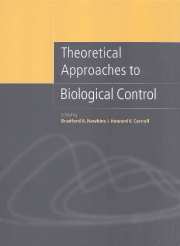Book contents
- Frontmatter
- Contents
- List of contributors
- Preface
- Part I Biological control theory: past and present
- Part II Ecological considerations
- Part III Spatial considerations
- Part IV Genetic/evolutionary considerations
- 13 Population dynamics and the evolutionary stability of biological control
- 14 Genetic conflict in natural enemies: a review, and consequences for the biological control of arthropods
- 15 The evolution of overexploitation and mutualism in plant–herbivore–predator interactions and its impact on population dynamics
- 16 A Darwinian view of host selection and its practical implications
- Part V Microbes and pathogens
- Index
14 - Genetic conflict in natural enemies: a review, and consequences for the biological control of arthropods
from Part IV - Genetic/evolutionary considerations
Published online by Cambridge University Press: 13 August 2009
- Frontmatter
- Contents
- List of contributors
- Preface
- Part I Biological control theory: past and present
- Part II Ecological considerations
- Part III Spatial considerations
- Part IV Genetic/evolutionary considerations
- 13 Population dynamics and the evolutionary stability of biological control
- 14 Genetic conflict in natural enemies: a review, and consequences for the biological control of arthropods
- 15 The evolution of overexploitation and mutualism in plant–herbivore–predator interactions and its impact on population dynamics
- 16 A Darwinian view of host selection and its practical implications
- Part V Microbes and pathogens
- Index
Summary
Introduction
We generally think of the DNA of an organism acting in a concerted manner to direct the development and behavior of that organism. However, a recent and rapidly growing body of literature suggests that the interests of different DNA lineages within organisms may sometimes be in conflict. Genetic conflict may arise between different genes or chromosomes within the nuclear genome, or between the nuclear genome and the DNA of cytoplasmic parasites such as viruses or bacteria. Although the origin of these elements spans a range of relatedness to the host, from within the same genetic population to unrelated microorganisms, they function similarly to enhance their own fitness at the cost of other lineages; here, all will be categorized as ‘selfish genetic elements’. The effects of these elements on the phenotype are varied, but they include sex ratio distortion, when the inheritance of the element is exclusively through one sex, and mating incompatibility, when the male of the pair carries a different strain of microbe than the female.
While the discovery of the existence of many of these types of elements is recent, and relatively few systems are well understood, preliminary evidence suggests that selfish genetic elements may be very widespread. For example, Wolbachia, bacteria that cause mating incompatibility in many insects and parthenogenesis in parasitic wasps, have been found in over 80 insect species, as well as in several isopods and a mite (Werren, 1997a).
- Type
- Chapter
- Information
- Theoretical Approaches to Biological Control , pp. 231 - 258Publisher: Cambridge University PressPrint publication year: 1999
- 6
- Cited by



